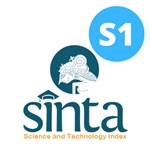PERBEDAAN GANGGUAN PENDENGARAN AKIBAT BISING ANTARA OPERATOR CCR PLTU DENGAN PLTGUDI PT PJB UP GRESIK
Downloads
ABSTRACT
The role of central control room (CCR) operator in Steam Power Plant (PLTU) or Gas and Steam Power Plant (PLTGU) of a work environment has high noise intensity with range (62.2– 99.8 dBA). Noise resulting from the process of production of electrical energy by machinery such as power generation unit boiler/HRSG, turbine, generator, condenser and other supporting equipment can cause Noise Induced Hearing Loss (NIHL). Study with cross-sectional design aims to analyze the difference in Noise Induced Hearing Loss between shift operator CCR PLTU and PLTGU PT PJB UP Gresik. Research on samples taken with the technique of simple random sampling with the majority of respondents were ≥ 40 years old, have a working periode ≥ 4 years, have a work area with a level of intensity noise > 85 dBA, long exposure noise ≤ 1 hour and good level of compliance of the use of ear protection in both of units. There was a difference of NIHL shift operator CCR PLTU and PLTGU. The number ofoperator who have experienced hearing loss due to noise on the shift operator CCR PLTU greater than PLTGU. Shift operator CCR PLTU and PLTGU are advised to obey and comply with safe working hours in areas with particular noise intensity has been set and the use of ear protection with right, also have to perform regular an audiometry exam tests so that the function of hearing of shift operator CCR could in monitor continuously.
Keywords: central control room operator, power plant, noise induced hearing lossA.G. Adji, M. 2015. Info PJB: PJB Siap Sukseskan 35 GW. Media Informasi dan Komunikasi PJB. Edisi 92.Februari 2015. Jakarta.
Rafika, A. 2012.Pengaruh Kebisingan terhadap Nilai Ambang Dengar Pada Pekerja Yang Terpapar Bising di PT PJB Unit Pembangkitan Gresik Studi Area PLTU 3 dan 4 PT PJB UP Gresik. Skripsi. Surabaya; Universitas Airlangga.
Bashiruddin, J. dan Soetirto, I. 2012. Gangguan Pendengaran Akibat Bising (Noise Induced Hearing Loss). Dalam Soepardi, E.A., Iskandar, N., Bashiruddin, J, dan RD. Restuti. Buku Ajar Ilmu Kesehatan Telinga, Hidung, Tenggorok, Kepala dan Leher. Edisi 5. Jakarta: Badan Penerbit FK UI. 42–45.
Dibyaguna, D.I. 2014. Faktor yang Berhubungan dengan Gangguan Pendengaran Pada Operator di PLTU PT PJB Unit Pembangkitan Gresik.Tugas Akhir. Surabaya; Universitas Airlangga.
Djojodibroto, Darmanto. 1999. Kesehatan Kerja di Perusahaan. Jakarta. Penerbit: PT Gramedia Pustaka Utama.
European Agency for Safety and Health at Work. 2008. Combined Exposures to Noise and Ototoxic Substance. European Risk Observatory Literature Review . L u x e m b o u rg : O ff i c e f o r O ff i c i a l Publications of The European Communities.
Harrington, JM. 2003. Buku Saku Kesehatan Kerja. Penerbit Buku Kedokteran, EGC: Dublin, Ohio. Irwandi, R. 2008. Penyakit Akibat Kerja dan Penyakit Terkait Kerja. (online). Dari:http://library.usu. ac.id/download/ft/07002746.pdf (sitasi:2 Agustus 2015).
Notoatmodjo, S. 2012. Metodologi Penelitian Kesehatan. Jakarta: Rhineka Cipta.
Novita, S dan Yuwono, N. 2014. Diagnosis dan Tata Laksana Tuli Mendadak. (online). Dari: http://www. kalbemed.com/Portals/6/07_210Diagnosis%20 dan%20Tata%20Laksana%20T uli%20
Mendadak.pdf (sitasi 2 Agustus 2015).
Peraturan Menteri Tenaga Kerja dan Transmigrasi Nomor 13 Tahun 2011 tentang Nilai Ambang Batas Faktor Fisika dan Faktor Kimia di Tempat Kerja.
Prayogo, I. 2015. Analisis Perbedaan Gangguan Pendengaran (Auditori), Keluhan Subyektif Kelelahan Mata, dan Stres Kerja Studi Antara Operator Bergilir Central Control Room PLTU dan PLTGU di PT PJB Unit Pembangkitan Gresik. Skripsi. Surabaya: Universitas Airlangga.
PT. PLN (Persero). 2013. Statistik PLN 2013. Jakarta: Sekretariat Perusahaan PT PLN (Persero).
Sasongko.D.P., dkk. 2000. Kebisingan Lingkungan. Universitas Diponegoro: Semarang.
Soetirto, I. 1997.”Tuli Akibat Bising (Noise Induced Hearing Loss)” dalam Buku Ajar Ilmu Penyakit Telinga Hidung Tenggorok Edisi Ketiga. Editor: H. Efiaty A. Soepardi, dokter, DSTHT dan Prof. H. Nurbaiti Iskandar, dokter, DSTHT, Penerbit: FKUI: Jakarta.
Suliyantoko, A dan Sutomo. 2009. Pengendalian Operasi PLTU dan PLTGU. Jakarta: Lintang Pancar Semesta.
Suma'mur, P.K. 2009. Higiene Perusahaan dan Kesehatan Kerja (Hiperkes). Sagung Seto: Jakarta.
Siswanto, A. 1998.Kebisingan. Surabaya: Balai Hiperkes dan Keselamatan Kerja Jawa Timur. Tambunan, S.T.B. 2005.Kebisingan di Tempat Kerja
(Occupational Noise). Andi: Yogyakarta. Turmaningsih, S.P. 2010. Analisis Hubungan Umur dan Lama Pemajanan dengan Daya Dengar Berdasarkan Hasil Pemeriksaan Audiometri Tenaga Kerja di Unit Produksi Central Processing Area.
J o b P - P E J T u b a n J a w a T i m u r . S k r i p s i .
Surakarta: Fakultas Kedokteran Universitas Sebelas Maret. http://eprints.uns. ac.id/8129/1/144411308201009471.pdf (Diakses tanggal 3 Agustus 2015).

In order to be accepted and published by The Indonesian Journal of Occupational Safety and Health, Author(s) who submit an article should complete all the review process. The copyright of received articles assigned to the The Indonesian Journal of Occupational Safety and Health and Department of Safety and Health, Universitas Airlangga as publishers of the journal. The intended copyright includes the rights to publish articles in various forms (including reprints).
The Editorial Team of The Indonesian Journal Of Occupational Safety and Health and Department of Safety and Health strive to ensure that no errors occur in the articles that have been published, both data errors and statements in the article.
Users of this website will be licensed to use materials from this website following the Creative Commons Attribution-NonCommercial-ShareAlike 4.0 International License. No fees charged. Please use the materials accordingly.
------------------------------------------------------------------------------------------------------------------------------------------------------------------------------------------
Attribution ” You must give appropriate credit, provide a link to the license, and indicate if changes were made. You may do so in any reasonable manner, but not in any way that suggests the licensor endorses you or your use.
NonCommercial ” You may not use the material for commercial purposes.
ShareAlike ” If you remix, transform, or build upon the material, you must distribute your contributions under the same license as the original.







 How to Submit Articles in OJS
How to Submit Articles in OJS

























